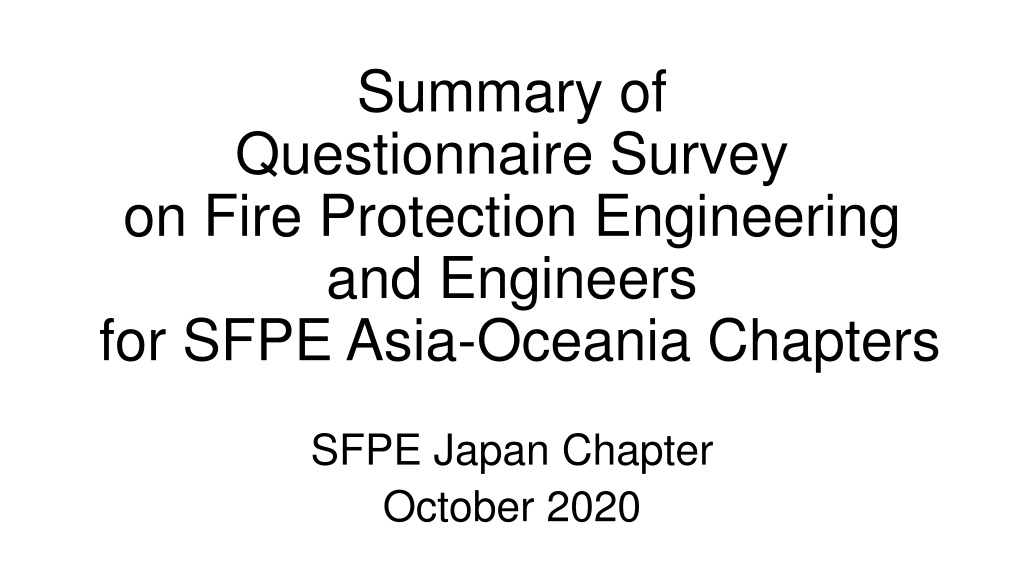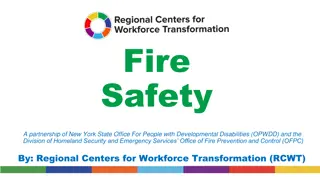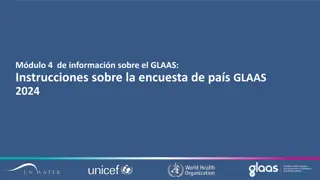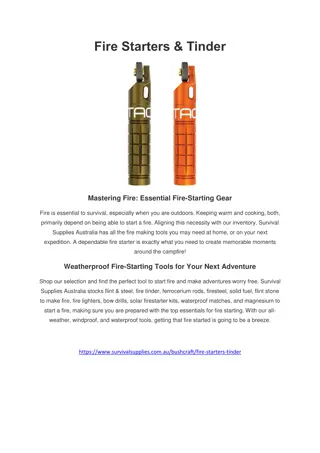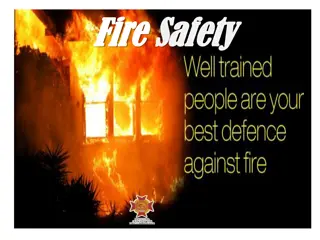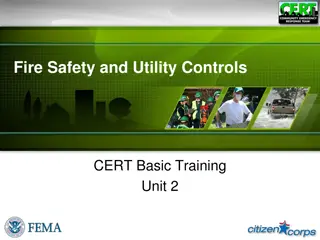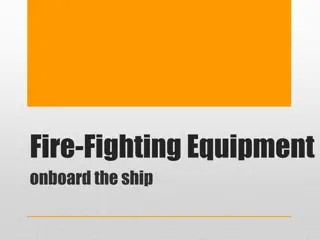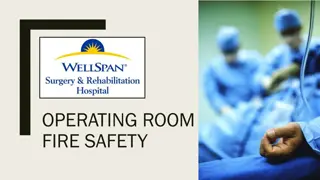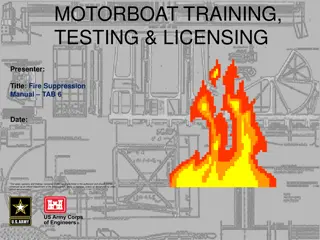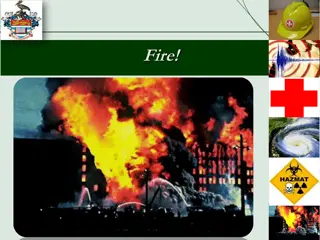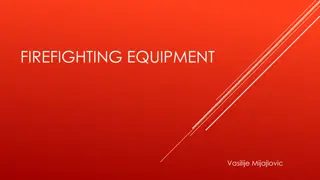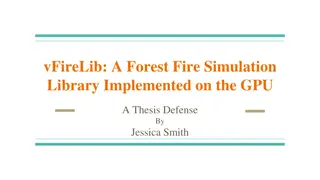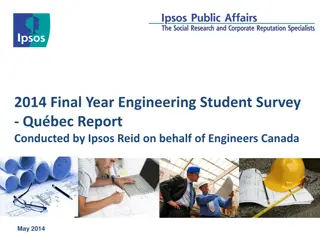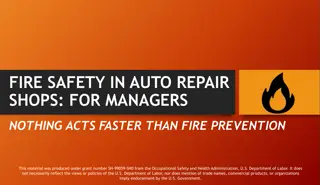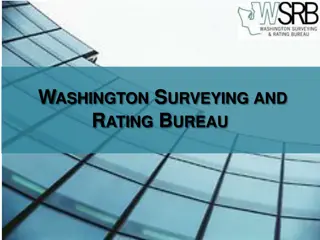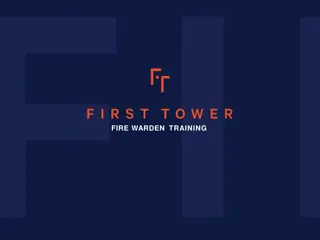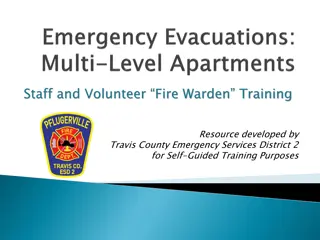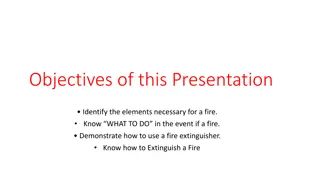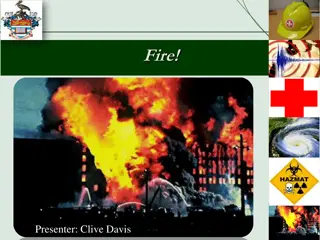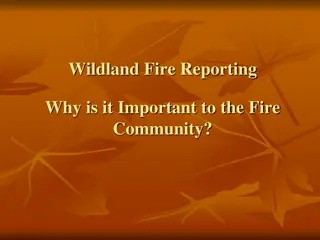Summary of Survey on Fire Protection Engineering
Survey conducted by SFPE Japan Chapter in October 2020 to understand the regulatory systems, guidelines, and qualification requirements for Fire Protection Engineering in Asia-Oceania region. Results indicate varying practices among 11 countries surveyed, shedding light on the current landscape of fire protection standards in the region.
Download Presentation

Please find below an Image/Link to download the presentation.
The content on the website is provided AS IS for your information and personal use only. It may not be sold, licensed, or shared on other websites without obtaining consent from the author.If you encounter any issues during the download, it is possible that the publisher has removed the file from their server.
You are allowed to download the files provided on this website for personal or commercial use, subject to the condition that they are used lawfully. All files are the property of their respective owners.
The content on the website is provided AS IS for your information and personal use only. It may not be sold, licensed, or shared on other websites without obtaining consent from the author.
E N D
Presentation Transcript
Summary of Questionnaire Survey on Fire Protection Engineering and Engineers for SFPE Asia-Oceania Chapters SFPE Japan Chapter October 2020
Objectives of the questionnaire survey Until a few years ago since 2006, SFPE chapters in Asia and Oceania region have been holding exchange meetings roughly once a year to exchange a situation of each chapter. However, since this meeting was suspended for recent few years, it became difficult to share the latest situations each other. Therefore, we Japan chapter discussed with SPFE headquarters and concluded that it would be helpful to conduct a questionnaire survey to know about the situation of each chapter. Based on the results of this questionnaire, we would like to think over the strategy to enhance the activity of this region. 2
Outline of the survey Method of implementation by E-mail Implementation period from July to August in 2020 Target of questionnaire Chapter leaders of Asia-Oceania region Number of the responding 11 countries countries CHINA INDIA INDONESIA JAPAN KOREA MACAU MALASIA TAIWAN VIETNAM HONG KONG NEW ZEELAND 3
The results of survey (1) (Question 1) Is there any legal building regulatory system (namely regulation, law, guidance, and/or Authority having Jurisdiction (AHJ) etc.) that allows the application of Fire Protection (hereafter, FP) Engineering ? (Answer(s)) Only one country among 11 countries answered there is none. CHINA INDIA INDONESIA JAPAN KOREA MACAU MALASIA TAIWAN VIETNAM HONG KONG NEW ZEELAND YES YES NO YES YES YES YES YES YES YES YES 5
The results of survey (2) (Question 2) Is there any nationally popular guideline of FP Engineering? (Answer(s)) The one country answered that the SFPE Handbook of Fire Protection Engineering is popular. CHINA INDIA INDONESIA JAPAN KOREA MACAU MALASIA TAIWAN VIETNAM HONG KONG NEW ZEELAND NO YES NO YES YES YES NO YES YES YES YES 6
The results of survey (3) (Question 3) Are there requirements for the qualification of practitioners of FP Engineering? (Answer(s)) In seven among eleven countries, there is a certification system. CHINA INDIA INDONESIA JAPAN KOREA MACAU MALASIA TAIWAN VIETNAM HONG KONG NEW ZEELAND NO NO NO NO Education Education Education Certification Certification Certification Certification Certification Certification Certification Other Other 7
The results of survey (4) (Question 4) Is there any education program of FP Engineering professionals? (Answer(s)) Most of the countries answered that they have a university course specialized in FP Engineering. CHINA INDIA INDONESIA JAPAN KOREA MACAU MALASIA TAIWAN VIETNAM HONG KONG NEW ZEELAND YES YES YES NO YES NO NO YES YES YES YES 8
The results of survey (5) (Question 5) In which area, is performance-based design applicable? (Answer(s)) Fire safety and Structural design in most of countries. CHINA INDIA INDONESIA JAPAN KOREA MACAU MALASIA TAIWAN VIETNAM HONG KONG NEW ZEELAND Fire safety Fire safety Fire safety Fire safety Fire safety Fire safety Fire safety Fire safety Fire safety Fire safety Structure Structure Structure Structure Structure Structure Structure Structure Structure Structure Cultural heritage Cultural heritage Cultural heritage Cultural heritage Environment Environment Safety Safety Civil Eng. Civil Eng. Accessibility Accessibility Noise Energy 9
The results of survey (6) (Question 6) How and when does verification in the building process occur? (Answer(s)) A. at Time of Design, and Getting Building Permission B. at Time of Design, During Construction, At Occupancy CHINA INDIA INDONESIA JAPAN KOREA MACAU MALASIA TAIWAN VIETNAM HONG KONG NEW ZEELAND A A A B A A A A A A 10
The results of survey (7) (Question 7) When verifying building fire safety are there requirements for physical tests, calculation, engineering simulation, and review, ie. testing smoke management systems? (Answer(s)) All countries answered Yes. CHINA INDIA INDONESIA JAPAN KOREA MACAU MALASIA TAIWAN VIETNAM HONG KONG NEW ZEELAND YES YES YES YES YES YES YES YES YES YES YES 11
The results of survey (8) (Question 8) Is the insurance industry involved in the building design process? (Answer(s)) Five countries says Yes and six countries says No. CHINA INDIA INDONESIA JAPAN KOREA MACAU MALASIA TAIWAN VIETNAM HONG KONG NEW ZEELAND NO NO NO NO NO YES YES YES YES NO YES 12
The results of survey (9) (Question 9) What are Fire Protection Engineers (FPEs) at your chapter facing: challenges, problems, issues, or concerns; whether big or small, long-term/short-term, at local, national, regional, and global levels? (Answer(s)) Different countries have their own unique problems. Therefore, the Answer(s)s are shown in the following country by country. 13
The results of survey (9) (Question 9) What are you Fire Protection Engineers (FPEs) at your Chapter facing: challenges, problems, issues, or concerns; whether big or small, long-term/short-term, at local, national, regional, and global levels? CHINA (Answer(s)) SFPE membership are not legally recognized by the government in China, Hong Kong, and Macau. HONG KONG MACAU 14
The results of survey (9) (Question 9) What are you Fire Protection Engineers (FPEs) at your Chapter facing: challenges, problems, issues, or concerns; whether big or small, long-term/short-term, at local, national, regional, and global levels? (Answer(s)) The conscious of fire safety is very weak and fire protection still considered as costs for most investors/building owners in India. INDIA INDNESIAThe total lack and appreciation of fire safety issues and the low level of fire safety knowledge in the country in Indonesia. 15
The results of survey (9) (Question 9) What are you Fire Protection Engineers (FPEs) at your Chapter facing: challenges, problems, issues, or concerns; whether big or small, long-term/short-term, at local, national, regional, and global levels? (Answer(s)) Currently, in Vietnam and Japan, regulations and standards have provisions that are no longer appropriate to the actual situation, but have been slowly reviewed, amended and supplemented. JAPAN VIETNAM 16
The results of survey (9) (Question 9) What are Fire Protection Engineers (FPEs) at your Chapter facing: challenges, problems, issues, or concerns; whether big or small, long-term/short-term, at local, national, regional, and global levels? (Answer(s)) In New Zealand, there are; Inconsistent approach to peer review, Poor quality of FPEs in some sectors, and Inconsistent regulatory review. NEW ZEELAND 17
The results of survey (9) (Question 9) What are you Fire Protection Engineers (FPEs) at your Chapter facing: challenges, problems, issues, or concerns; whether big or small, long-term/short-term, at local, national, regional, and global levels? (Answer(s)) AHJs only focus on reviewing compliance to regulations and specifications, and ignore the needs and objectives of stakeholder objectives in the design stage in Taiwan. TAIWAN In Taiwan's building fire protection performance design, even if ASET and RSET are checked in engineering, it still cannot meet the performance requirements of the total fire safety. 18
The results of survey (10) (Question 10) How do FPEs at your Chapter work together? Meetings, workshops, site tours, etc.? What activities/events work well? What about things not working well? (Answer(s)) Generally saying, these activities/events are not so active except some countries like Japan, Taiwan and New Zeeland. 19
The results of survey (10) (Question 10) How do you FPEs at your Chapter work together? Meetings, workshops, site tours, etc.? What activities/events work well? What about things not working well? (Answer(s)) China chapter organizes seminar once a year. Cooperate with local organizations to participant in major fire events. CHINA HONG KONG Hong Kong chapter has meetings and CPD workshops. 20
The results of survey (10) (Question 10) How do you FPEs at your Chapter work together? Meetings, workshops, site tours, etc.? What activities/events work well? What about things not working well? (Answer(s)) As India chapter is relatively new, so there has been not many activities taken place except the meeting of the establishment of the chapter. INDIA INDNESIA The respondent in Indonesia says Workshops might be good idea. 21
The results of survey (10) (Question 10) How do you FPEs at your Chapter work together? Meetings, workshops, site tours, etc.? What activities/events work well? What about things not working well? (Answer(s)) Japan chapter holds the general meeting annually, WG activities concerning the current fire safety issues, seminars, and site tours. JAPAN In Macau chapter, local members share new and relevant developments to keep their skill current and active. Members participate in on-line seminars and courses when possible. MACAU 22
The results of survey (10) (Question 10) How do you FPEs at your Chapter work together? Meetings, workshops, site tours, etc.? What activities/events work well? What about things not working well? (Answer(s)) Monthly technical webinars are held by SFPE NZ Chapter. Some members of NZ chapter are represented on Standards committees and regulatory review committees. Emerging professional network has been facilitated by NZ Chapter for young engineers. Annual fire safety conference is held in NZ. NEW ZEELAND 23
The results of survey (10) (Question 10) How do you FPEs at your Chapter work together? Meetings, workshops, site tours, etc.? What activities/events work well? What about things not working well? (Answer(s)) Members of the SFPE Taiwan Chapter work hard in participating in government research projects on fire performance design and regulation review. TAIWAN VIETNAM In Vietnam, they have meetings, workshops, and investigations, events. 24
The results of survey (11) (Question 11) How can we collaborate on the matters above? Do you have any requests, suggestions, recommendations for the Society and/or Chapters to think about? Are there any ideas on collaborations among neighboring Chapters within Asia and Oceania region? (Answer(s)) Most of the countries propose regular meetings and seminars. But, if considering the current situation with Covid-19, online meeting and seminar are suggested by several countries. 25
The results of survey (11) (Question 11) How can we collaborate on matters above? Do you have any requests, suggestions, recommendations for the Society and/or Chapters to think about? Are there any ideas on collaborations among neighboring Chapters within Asia and Oceania region? CHINA (Answer(s)) Webinar within Asia-Oceania chapters once a year. Face to face meeting during major fire show in Asia. JAPAN HONG KONG Online/ Internet Forum. 26
The results of survey (11) (Question 11) How can we collaborate on matters above? Do you have any requests, suggestions, recommendations for the Society and/or Chapters to think about? Are there any ideas on collaborations among neighboring Chapters within Asia and Oceania region? Potentially form ASEAN SFPE chapters forum, for regular (say quarterly) meetings to discuss issues etc. IFE (The Institution of Fire Engineers) have a similar group. NEW ZEELAND The key persons of SFPE Taiwan chapter members are serving as public security consultants for the government. This experiences may be a reference for Asian countries. TAIWAN 27
The results of survey (11) (Question 11) How can we collaborate on matters above? Do you have any requests, suggestions, recommendations for the Society and/or Chapters to think about? Are there any ideas on collaborations among neighboring Chapters within Asia and Oceania region? (Answer(s)) It is good to have a meeting annually for the Oceania chapters to know each organization and discussion on the latest standard requirements of the individual countries. MALASIA 28
The results of survey (11) (Question 11) How can we collaborate on matters above? Do you have any requests, suggestions, recommendations for the Society and/or Chapters to think about? Are there any ideas on collaborations among neighboring Chapters within Asia and Oceania region? (Answer(s)) It is deemed necessary to establish guidelines for the PBD in Asia and Oceania. KOREA 29
Conclusion 1) Each country (or chapter) has different issues and demands depending on its social and historical background such as familiarity or intimacy to international organizations like SFPE or IFE, and the relationship between the government and the society. 2) Level of activity of each chapter is also different. 3) All chapters are positive for information exchange and real exchange meetings (if possible) in Asia/Oceania region. 3) For the time being, if considering the distance between countries in this region and the situation of Covid-19, holding regular online meetings is a realistic and very desirable idea. And, such proposals are found in the answer sheets from several countries. 30
